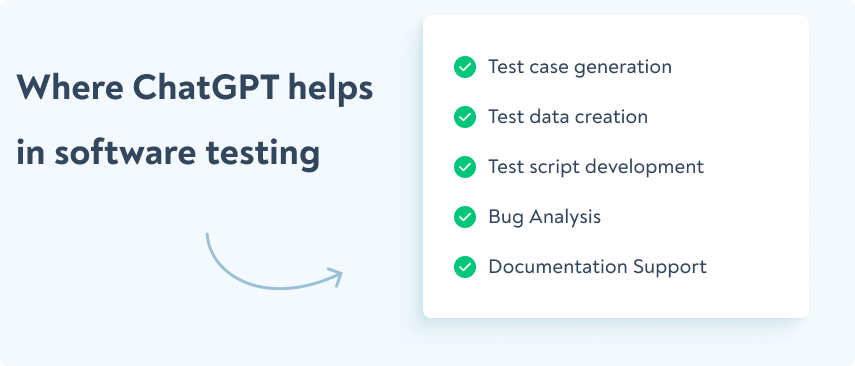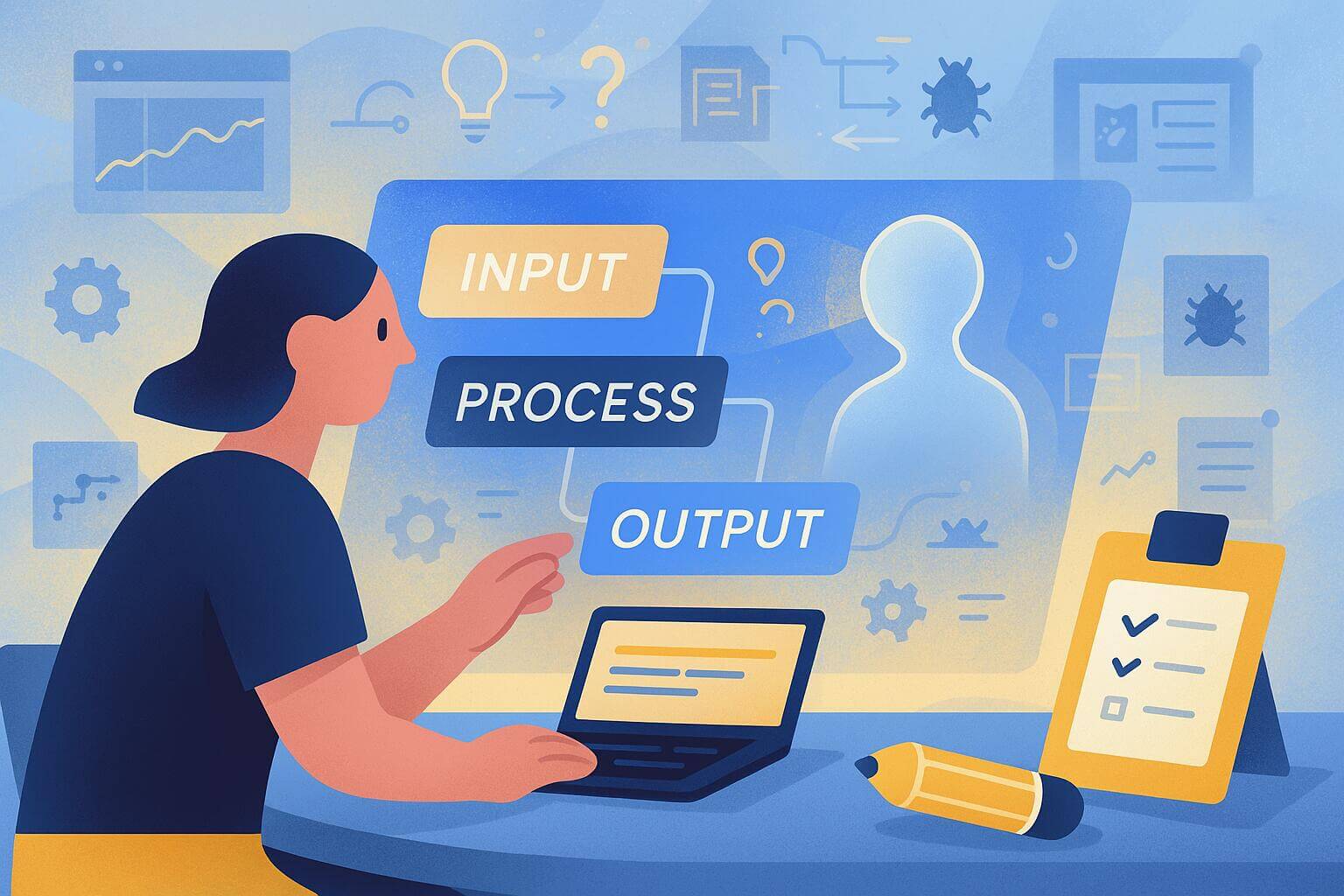Understanding GPT solutions’ Role in Software Testing
AI tools like ChatGPT are robust assistants in modern software testing. They offer support across multiple testing activities, which we’ll cover one by one. You can think of them as a specialised testing partner. A partner with extraordinary knowledge and the ability to generate content on demand.
When integrated properly into your testing workflow, ChatGPT helps with:
- Test case generation: You can generate large test cases based on requirements. You just need to feed this requirement to the AI and wait for the output.
- Test data creation: In your testing efforts, you’ll also need realistic, synthetic test data. AI can produce this test data that sets that match specifications easily.
- Test script development: You can also generate and optimise automation scripts with AI. All you need is to describe the test flow, so AI can write readable, optimised code for the testing frameworks.
- Bug analysis: You can spot the patterns of issues by feeding defect logs or reports into the AI. The bots will prioritise root causes, detect duplicate bugs, and suggest possible solutions.
- Documentation support: You can also speed up test documentation with AI. For this, you need to enable AI to generate formatted summaries, test plans, and reports from your prompt or test results.

I’m using AI for documenting code. Creating small pieces of code, enchanting defect report. Getting edge cases of new features. It is quite time saving.
For DevOps and Agile teams, these solutions provide particularly valuable advantages. These environments obviously have rapid iteration cycles. Requirements evolve all the time, and you can enhance them by quick test case generation and updates. Instead of updating test cases manually for days after each sprint planning meeting, you can instruct AI solutions to generate new test scenarios within minutes.
Take this scenario: A development team implements a new feature on an e-commerce site to store credit cards. Instead of taking hours coming up with test scenarios, an instant starting point of test cases like “Create detailed test cases for a new credit card storage feature, including security checks, expiration date management, and masking display” saves time to develop.
ChatGPT users who implement it well say they spend as much as 40% more time on exploratory testing and test planning strategy instead of mundane test case documentation.
Now imagine you have a test management solution (TMS) that is a better version of ChatGPT, and is entirely dedicated to your testing efforts. Apart from that, it respects your company’s privacy and security while continuously improving the knowledge of your project data.
Introducing aqua cloud, an AI-powered test management system, first solution implementing AI in QA. With aqua, you can generate requirements with a short brief or a voice prompt within just a few seconds. When you have your requirement, you can generate different types of test cases and test scenarios with a single click. Compared to manual approaches, it takes you 98% less time to implement. Need realistic test data too? Aqua’s AI copilot generates unlimited synthetic data for you in your third click. All you need is just 3 CLICKS, and aqua cloud saves up to 42% of your time on planning and test designing stages. You achieve all these while maintaining 100% coverage, visibility, and traceability
Get requirements, test cases, and unlimited test data within just 3 clicks
Top 10 Prompts for Software Testing
Prompting is not something you get instantly good at. You need to train your AI carefully, because the output completely depends on the input here.
Before diving into specific prompts, remember that effective prompts share certain characteristics:
- They provide context about the system under test
- They specify the desired output format
- They include relevant constraints or requirements.
The right prompt will transform your testing efficiency. Here are field-tested prompts categorised by testing activities that deliver exceptional results.
Test Case Generation Prompts
Let’s start with the core of testing efforts, test case generation prompts:
- Requirement-based test cases prompt: “Generate test cases for [feature description]. Include positive scenarios, negative scenarios, boundary conditions, and edge cases. Format each test case with ID, description, preconditions, steps, expected results, and test data.”
- API testing prompt: “Create API test scenarios for a [REST/SOAP/GraphQL] endpoint that [endpoint functionality]. Include tests for status codes, response validation, authentication failures, and performance thresholds. Structure as a table with request details and validation points.”
- Mobile app testing prompt: “Generate test cases for [specific mobile feature] considering different device sizes, orientations, OS versions (Android 11-13, iOS 15-16), offline mode, and interruptions like calls/notifications.”
- Security testing prompt: “Create security test cases for [feature] focusing on input validation, authorization checks, data encryption, session management, and protection against common attacks like SQL injection and XSS.”
Here are my following use cases:
1. Generating test scenarios for a specific feature. This helps me to make sure that I am covering all the possible test cases in a feature of the app.
2. In writing redundant automation test scripts. I had used GitHub Copilot in the past integrated with VSCode. It helped me to autocomplete codes like test block, describe block, page object class, etc.
3. To refactor the existing code. I understood the second person point of view in my coding work. It has significantly helped me to understand the other ways to implement same piece of code.
Bug Reporting Prompts
- Bug report template: “Generate a comprehensive bug report for the following issue: [brief description]. Include summary, steps to reproduce, expected vs. actual results, environment details, screenshots placeholder, severity assessment, and potential impact.”
- Bug analysis: “Analyse this error message and stack trace: [paste error]. Explain potential root causes, suggest investigation steps, and recommend possible fixes.”
Test Data Generation
- Structured data creation: “Generate a JSON dataset with 10 records for testing a user profile module. Include fields for user ID, name, email, age (18-65), registration date (within last 3 years), subscription type (free/premium/enterprise), and usage statistics.”
- Edge case data: “Create test data for boundary testing of a financial transaction system. Include examples at minimum/maximum transaction limits, currency edge cases, transaction timing edge cases, and unusual character handling.”
Risk Assessment Prompts
- Risk identification: “Analyse these requirements for [feature] and identify potential technical, business, and user experience risks. Rank each risk by impact and probability, and suggest mitigating test approaches.”
- Test prioritisation: “Given these user stories [list stories] and limited testing time of 3 days, recommend a test prioritization strategy with rationale. Consider business impact, technical complexity, and user visibility.”
You can customise each prompt to your specific project context. Experiment with variations to find what works best for your testing needs.
Best Practices for Crafting Effective Prompts
Your success with AI-assisted testing depends on how well you communicate with the model. If you follow these proven strategies to craft your prompts, you will get consistent results.
Be Specific and Detailed
- Provide context: Do not go vague. Include comprehensive information about everything related. 2 minutes of more prompting can save you an hour of back-and-forth with AI. So you need to cover the application type, target users, and relevant technical details fully.
- Specify output format: Request structured outputs. If your results is a plain text, then it is of low quality. Demand tables, numbered lists, or JSON when you see it fit.
- Include constraints: Mention limitations and specific focus areas (e.g., “focus on mobile responsive design issues”).
- Set clear expectations: State exactly what you want to receive (e.g., “Generate 10 test cases with steps and expected results”). If you don’t have the structure of the desired answer, how can AI give it to you? Don’t be lazy
Use Structural Techniques
- Few-shot prompting: Reminder again: AI is as good as your prompts, so training is essential. You need to show examples of desired output before asking for new content.
- Chain-of-thought: Ask the AI to break down complex testing problems step by step. This way, you will avoid getting vague, generic answers.
- Role assignment: Direct the AI to “act as an experienced security tester” or similar role. Might sound funny, but giving more details like “Imagine you are a 35 years old security tester, on the top 1% of your field for your technical skills” you can make your AI even more powerful.
- Use delimiters: Separate different parts of your prompt with characters like ### or “. This gives AI clarity and an opportunity to not mix everything together.
Continuous Editing & Refinement
- Start broad, then narrow: Begin with general prompts and refine based on results. Providing examples for each outcome helps here too.
- Ask for specific improvements: Direct refinements like “Make these test cases more focused on edge cases” will help AIs a lot.
- Build on previous outputs: Reference earlier generated content in follow-up prompts. Always focus on clarity, do not just say “based on the earlier content, do x”. Instead, copy that desired content and put it into your current prompt.
Maintain conversation context: Build a dialogue rather than starting from scratch. Ask GPT to give you a list of questions before moving forward. It will help both you and AI in your dialogue.
Common Patterns to Avoid in Prompting
Working with GPT solutions looks easy, but it is not. You need to avoid some “lazy mistakes” most people make, so you can get the best out of AI. Avoid all the following:
- Ambiguous requests: “Generate some good test cases” is too vague. Explain what good test case is for you. Give as many details as you can.
- Overly complex multi-part questions: Break complex requests into sequential prompts. Over-complication also confuses AI, so having structure as you go is a must.
- Technical jargon without explanation: Define domain-specific terms when necessary. Sometimes AI can confuse these specific terms that are same or similar with those of other fields or industries. In this case, the results can be much different from what you desire.
- Assuming technical knowledge: AI does not know where you work at, what frameworks, languages, or environments you’re working with. It is your responsibility to feed them into AI.
When a prompt tester experiments with these techniques, the results improve massively. For example, changing “Give me some API test cases” to “Generate 5 test cases for a REST API that handles user authentication, including edge cases for invalid credentials, token expiration, and rate limiting. Format each test with prerequisites, request details, expected response codes, and validation checks” produces much more useful and detailed test cases.
Challenges and Limitations of AI in Software Testing
AI assistance offers tremendous benefits but you also need to understand its limitations. It helps you use AI effectively and avoid potential problems in your testing process:
Context Limitations
ChatGPT lacks direct access to your codebase or application, which creates several challenges:
- Limited understanding of application specifics: The model cannot inspect your actual code or application behaviour
- No awareness of recent changes: It cannot track code changes or updates unless you explicitly describe them
- Missing historical context: It doesn’t remember previous bugs or pattern issues in your specific software
Solution: Provide relevant code snippets, architecture diagrams, or detailed descriptions of the application behaviour when crafting your prompts.
Technical Accuracy Concerns
AI models occasionally produce inaccurate or outdated technical information:
- Framework-specific syntax errors: Generated test scripts may contain syntax errors or outdated API calls
- Inconsistent naming conventions: Generated test cases might not follow your team’s conventions
- Outdated practices: Some suggested approaches might not align with current best practices
Solution: Always review and verify technical outputs before implementation. Use the AI for initial drafts that you refine rather than final products.
Over-Reliance Risks
Getting help from AI is almost mandatory for speed and efficiency. But depending too heavily on AI assistance carries risks:
- Critical thinking atrophy: Testers may lose some analytical skills if they routinely outsource thinking to AI
- Missing novel issues: AI tends to focus on common patterns and might miss highly unusual edge cases
- False confidence: Well-formatted, professional-looking output can create unwarranted confidence
Solution: Use AI as a complementary tool rather than a replacement for human expertise. Maintain a healthy balance between AI assistance and manual testing efforts.
Privacy and Security Considerations
Data shared with AI models raises important considerations:
- Sensitive information exposure: Avoid sharing private user data, credentials, or proprietary code
- Compliance issues: Be aware of regulatory requirements regarding data processing
- Intellectual property concerns: Consider what proprietary information you’re comfortable sharing
Solution: Sanitise sensitive information before sharing it with AI. Use synthetic data and generic descriptions when discussing proprietary systems.
We have good news for you: AI-powered TMS aqua cloud helps you even through the above-mentioned challenges and limitations. To generate a detailed, complete test case, you just need to give AI your requirement. Unlimited test data takes an extra click from you, nothing more. Complexity is no problem for aqua’s AI too: it can understand context, and is specifically designed for your testing efforts. Aqua meets highest security or compliance standards, so you don’t need to be afraid of your sensitive data being leaked. Your data remains inside your project and will never be used to train the AI outside of it. AI chatbot will answer all your concerns and questions along the way, all the while you keep 100% traceability, coverage and visibility. So let’s put it into context for you: aqua cloud is much better and absolutely more secure than ChatGPT, and specifically for your testing efforts.
Step into the world of AI testing with limited prompting knowledge
Conclusion
Prompt engineering is already an essential skill for modern software testers. It helps you get real value from AI tools like ChatGPT. Learn to craft clear, structured prompts and you can speed up tasks like test case generation, documentation, and bug analysis. The key is to be specific, refine your prompts based on results, and treat AI as a smart assistant, not a replacement. Great teams build and share prompt libraries, learn from each other, and keep improving. The more you practice, the more you’ll shift your focus from repetitive tasks to finding the bugs that actually impact users.


















